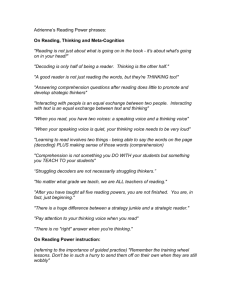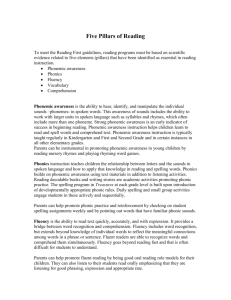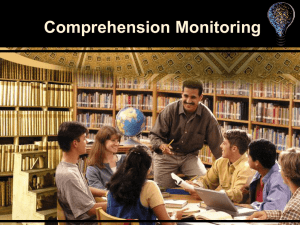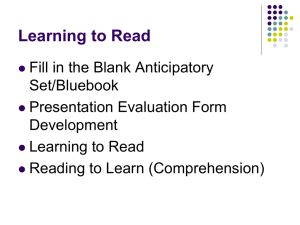Session 2 Types of Assessments (Informal Vs Formal)
advertisement
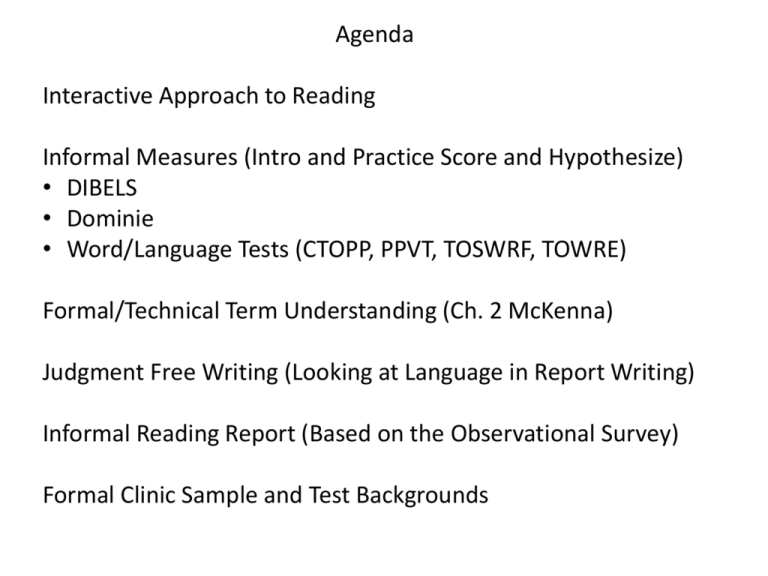
Agenda Interactive Approach to Reading Informal Measures (Intro and Practice Score and Hypothesize) • DIBELS • Dominie • Word/Language Tests (CTOPP, PPVT, TOSWRF, TOWRE) Formal/Technical Term Understanding (Ch. 2 McKenna) Judgment Free Writing (Looking at Language in Report Writing) Informal Reading Report (Based on the Observational Survey) Formal Clinic Sample and Test Backgrounds Ten Characteristics of Texts • • • • • Genre Text Structure Content Themes and Ideas Language and Literary Features • • • • • Sentence Complexity Vocabulary Words Illustrations Book and Print Features The Continuum of Literacy Learning, Grades K-2 – p. 9 – 11 The Continuum of Literacy Learning, Grades K-8 – p. 16 - 17 Teaching for Comprehending and Fluency – p. 160 Models of Reading • Bottom-up processing (decoding) • Top-down processing • Interactive approach The cat is in the grass. The cat is in the lady’s lap. Oh no, the cat is in the tree. •Peter led Bridget into the waiting room. •He realized that she was extremely nervous, so he gently suggested that she sit down. •Bridget ignored him and began to pace frantically. •The other patients watched her warily and several also began pacing. •As a scream rang out from the inner office, Peter angrily forced Bridget to sit down. •Bridget moved closer to Peter, who leaned down and tenderly scratched her ears. Bottom-up Processing Reader builds meaning from the smallest units of meaning to achieve comprehension. Example letters letter clusters words phrases sentences longer text meaning = comprehension Top-down Processing Reader generates meaning by employing background knowledge, expectations, assumptions, and questions, and reads to confirm these expectations. Example Pre-reading activities (i.e. activating schema, previewing, and predicting) + background knowledge (cultural, linguistic, syntactic, and historical) = comprehension Aebersold, J. & Field, M. L., (1997). From reader to reading teacher: Issues and strategies for second language classrooms. New York: Cambridge University Press. Interactive Approach Reader uses both bottom-up and topdown strategies simultaneously or alternately to comprehend the text. Example Reader uses top-down strategies until he/she encounters an unfamiliar word, then employs decoding skills to achieve comprehension. Aebersold, J. & Field, M. L., (1997). From reader to reading teacher: Issues and strategies for second language classrooms. New York: Cambridge University Press. Interactive Approach Knowledge base + bottom-up strategies + top-down strategies = comprehension Which model should be adopted? The reader must be competent in both bottom-up and top-down processing. Nunes, T. (1999). Learning to read: An integrated view from research and practice. Dordrecht, The Netherlands: Kluwer. Assessment Trade-Offs Norm-referenced Comparability Group administered Informal In depth information Individually administered Rule of Thumb The finer the grain size at which we monitor a process, like reading or writing, the greater the likelihood that we will end up teaching and testing bits and pieces rather than global processes like comprehension and composition. P. David Pearson, UC Berkeley CORE Pages 8-9 Typical Questions Types of Assessments Purpose Formative Who is at risk? Who needs close monitoring? What are a student’s strengths? weaknesses? Are other students exhibiting similar profiles? Who needs extra support? How should groups be formed? Which skills need to be emphasized Have we accomplished our goals for a student? a class? a school? a district? What aspects of the literacy program need revision? Universal Screening “First Alert” Formative Diagnostic Formative Progress Monitoring “In-depth View” “Growth Charts” Summative Outcome “Reaching Our Goals” Effective instruction is the only solution • Children differ • Struggling readers differ • Intervention designs must be based on knowledge of these differences • Figuring out how to best teach each struggling reader is the essential task Allington Fluency & Comprehension Progress Monitor Phonics Phonemic Awareness Phonics, Phonemic Awareness, Fluency Vocabulary and Comprehension Phonemic Awareness • Is phonemic awareness the same thing as phonological awareness? • Is phonemic awareness the same thing as phonics? a m p v s If you can do it with your eyes closed, it is phonemic awareness! © 2005c, Dynamic Measurement Group 29 Focus on Big Ideas • Alphabetic Principle: Based on two parts. - Alphabetic Understanding: Letters represent sounds in words. a m p v s © 2005c, Dynamic Measurement Group 30 Focus on Big Ideas • Alphabetic Principle – Phonological Recoding: Letter sounds can be blended together and knowledge of letter-sound associations can be used to read/decode words. a m p © 2005c, Dynamic Measurement Group 31 Focus on Big Ideas • Accuracy and Fluency – Automaticity with fundamental skills so that reading occurs quickly and effortlessly; e.g., driving a car, playing a musical instrument, playing a sport © 2005c, Dynamic Measurement Group 32 Focus on Big Ideas Vocabulary • Understanding and use of words - Ability to say a specific word for a particular meaning - Ability to understand spoken/written words © 2005c, Dynamic Measurement Group 33 Focus on Big Ideas Comprehension • The process of getting meaning from spoken language and/or print. © 2005c, Dynamic Measurement Group 34 Dominie Reading and Writing Portfolio My dad loves to fly a kite. He makes it go high above the trees. •Reviewing Tests •Test Protocols •Materials Picture Walk Test Name: Guided Practice Reactions: Components Addressed:(NRP) Data Generated: (Stanines, G.E.s etc.) Reliability Information: Validity Information: Implications for Instruction/Recommendations: The only way to create fewer students with limited reading proficiency is to provide those students with more and better reading instruction than that provided to the other students.” (Allington, 2009, p.11)



